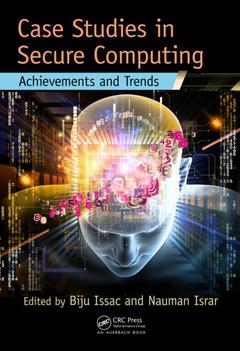Description
Case Studies in Secure Computing
Achievements and Trends
Coordinators: Issac Biju, Israr Nauman
Language: English
Subjects for Case Studies in Secure Computing:
Keywords
Data Set; Packet Filtering; Survey of Secure Computing; Sensor Nodes; Web Application Security Attacks and Countermeasures; Session Id; Fuzzy Logic-Based Application Security Risk Assessment; Session Key; Authenticated Multiple-Key Establishment Protocol for Wireless Sensor Networks; Reversible Watermarking; Optimizing Ant-Based Internet Protocol Traceback; Cloud Computing; OWASP; Cloud Providers; Cloud Environment; Random Oracle Model; Session Fixation; Cloud Service; WSNs; Master Secret Key; Watermarked Image; PHP Code; Secret Key; Communication Overhead; Web Applications; Session Hijacking; Partial Private Key; Mobile Networks; XSS Attacks; Guest OSs
Publication date: 09-2014
· 17.8x25.4 cm · Hardback
Publication date: 10-2016
· 17.8x25.4 cm · Paperback
Description
/li>Contents
/li>Readership
/li>Biography
/li>
In today?s age of wireless and mobile computing, network and computer security is paramount. Case Studies in Secure Computing: Achievements and Trends gathers the latest research from researchers who share their insights and best practices through illustrative case studies.
This book examines the growing security attacks and countermeasures in the stand-alone and networking worlds, along with other pertinent security issues. The many case studies capture a truly wide range of secure computing applications. Surveying the common elements in computer security attacks and defenses, the book:
- Describes the use of feature selection and fuzzy logic in a decision tree model for intrusion detection
- Introduces a set of common fuzzy-logic-based security risk estimation techniques with examples
- Proposes a secure authenticated multiple-key establishment protocol for wireless sensor networks
- Investigates various malicious activities associated with cloud computing and proposes some countermeasures
- Examines current and emerging security threats in long-term evolution backhaul and core networks
- Supplies a brief introduction to application-layer denial-of-service (DoS) attacks
Illustrating the security challenges currently facing practitioners, this book presents powerful security solutions proposed by leading researchers in the field. The examination of the various case studies will help to develop the practical understanding required to stay one step ahead of the security threats on the horizon.
This book will help those new to the field understand how to mitigate security threats. It will also help established practitioners fine-tune their approach to establishing robust and resilient security for next-generation computing systems.
Intelligent Computing Case Studies. Secure Computing Case Studies.
Dr. Biju Issac is a senior lecturer at the School of Computing, Teesside University, United Kingdom, and has more than 15 years of academic experience with higher education in India, Malaysia, and the United Kingdom. He earned a PhD in networking and mobile communications, along with MCA (master of computer applications) and BE (electronics and communications engineering).
He is a senior Institute of Electrical and Electronics Engineers (IEEE) member, a fellow of the Higher Education Academy, an Institution of Engineering and Technology (IET) member, and a chartered engineer (CEng). He is a CISCO-Certified Network Associate (CCNA) instructor, a Sun-Certified Java instructor, and a Lotus Notes professional. His broad research interests are in computer networks, wireless networks, computer or network security, mobility management in 802.11 networks, intelligent computing, data mining, spam detection, secure online voting, e-learning, and so forth. Dr. Issac has authored more than 60 peer-reviewed research publications, including conference papers, book chapters, and journal papers. He has supervised postgraduate research students to completion. He is in the technical program committee of many international conferences and on the editorial board of some journals and has reviewed many research papers.
Dr. Nauman Israrhas been a senior lecturer at the School of Computing, Teesside University, United Kingdom, for many years. He earned his PhD in wireless sensor networks at the University of Bradford, United Kingdom. He teaches computer networks–related subjects at the university. His areas of research expertise are wireless sensor networks, wireless networked control systems, fly-by-wireless systems, active aircraft, and wireless embedded systems. Dr. Israr was a research fellow at Queen’s University Belfast (Active Aircraft Project). The aim of that project was to design and develop a wireless nervous




